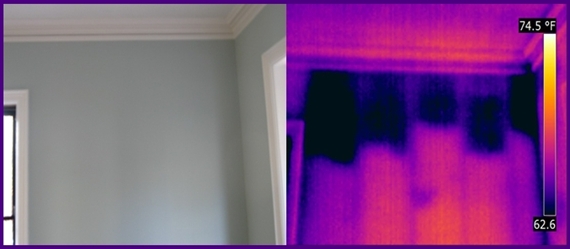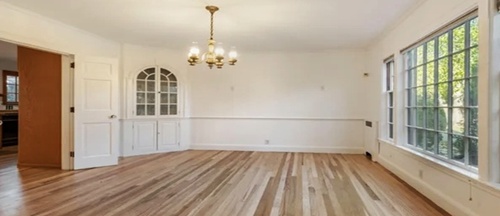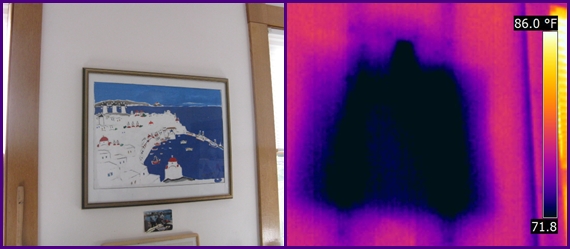Enhance Your Infrared Scan
See What's Really Going On!
INFRARED SCAN PREPARATION

When scheduling an infrared scan with me, please ensure your home is properly prepared to avoid any issues during the thermal scan. To maximize the accuracy and effectiveness of your scan, please follow these important guidelines:
1. Establish the Proper Temperature Differential (Delta T) - In winter, increase the indoor temperature by turning up the heat at least 15–20°F warmer than the outside. In summer, lower the indoor temperature with air conditioning to 15–20°F cooler than the outside. If you don’t have A/C in the summer, consider scheduling a winter inspection to obtain optimal results.
2. Close Windows and Doors - Shut all windows and exterior doors several hours before the scan to prevent outside air from affecting the results.
3. Turn Off Fans and Ventilation Systems - Ceiling fans, exhaust fans, and whole-house ventilation systems can create air movement that may interfere with detecting air leaks and insulation gaps.
4. Remove Obstacles Near Walls and Ceilings - Move furniture, wall hangings, and large objects at least a few feet away from all outermost walls to allow a clear view of all wall surfaces of concern. Raise drapes away from all walls of concern. Do not be concerned with any interior walls as these walls are of no concern for thermal efficiency.

5. Opening closet doors (situated on the outermost exterior wall) and conditioning the closet space will help me identify any exterior wall defects within them. Since I cannot move personal belongings for liability reasons, please ensure that most of your closet walls are clearly visible to the infrared camera. Any blocked areas could potentially hide underlying issues.

6. Avoid Direct Sunlight on Interior Surfaces - If possible, close blinds or curtains to prevent sunlight from heating interior walls, which can create false readings.
7. Do Not Use Fireplaces or Space Heaters - These can create localized hot spots that may distort the infrared scan results.
8. Inform Household Members - Let everyone know when the infrared scan will take place and ask them to avoid opening doors or making sudden temperature changes during the inspection.
By following these steps, you’ll create the best conditions for an accurate and effective infrared scan of your home.
Interior Scanning vs. Exterior Scanning
Interior infrared scans are generally more effective than exterior scans for several reasons:
1) Reduced Air Movement – Wind and outdoor air currents can quickly dissipate temperature differences on exterior surfaces, making anomalies harder to detect. Inside, air movement is minimal, preserving the temperature contrast needed for accurate readings.
2) Stable Temperature Conditions – Interior surfaces are less affected by external factors such as sunlight, wind, and precipitation, which can mask or distort thermal anomalies. This stability allows for clearer thermal imaging results.
3) Direct Detection of Anomalies – Infrared scans from inside the building can directly capture temperature variations caused by issues like insulation gaps, air leaks, or moisture intrusion. On exterior surfaces, these anomalies may be masked by external environmental factors.
4) More Reliable Detection of Air Leaks – Conditioned air escaping through walls may disperse unpredictably outside due to wind, making it difficult to trace the source of leaks. Inside, infrared imaging can pinpoint the exact location of air leaks with greater accuracy due to minimum air movement.
5) No Influence from Solar Heating – Sunlight can cause exterior surfaces to heat unevenly throughout the day, creating thermal patterns that may not be related to actual building defects. Interior scans avoid this issue by focusing on controlled indoor conditions.
For these reasons, interior infrared scans typically provide more accurate and reliable results compared to exterior scans.
IMPORTANT: Please do yourself a favor and do not wait until I arrive at your house to start moving your furniture and bedding away from the walls. Make sure every portion of your walls is conditioned for at least one hour beforehand to help identify any concealed defects. Furniture pressed against the walls prevents proper conditioning, which can affect infrared readings. Unconditioned areas (where furniture was placed) will always appear defective, as conditioned air cannot pass through furniture.
EXAMPLE
If you wait until I arrive to pull your furniture away from the wall, this is what my infrared camera will detect:

EXAMPLE
If you remove your pictures from the wall after I arrive, this is what my infrared camera will detect:

The images above show what my infrared camera detects when pictures and furniture are removed during the scan. If you want specific walls thermally scanned during my walk-through, please move wall hangings and furniture away from these areas at least one hour before my arrival to allow the walls to acclimate to the space. It makes the report much easier to understand so you know whats really going on behind those walls.
For more information, please go to the top right corner and click "Navigate."